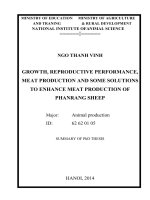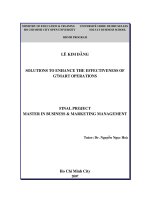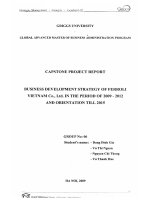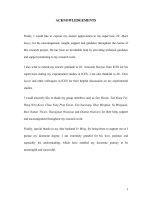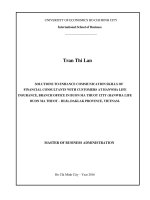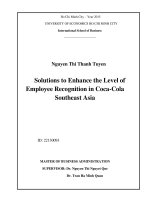Solutions to enhance the quality of ocean freight at DB schenker vietnam co ltd in the globalization context 4
Bạn đang xem bản rút gọn của tài liệu. Xem và tải ngay bản đầy đủ của tài liệu tại đây (460.23 KB, 74 trang )
SOLUTIONS TO ENHANCE THE QUALITY OF OCEAN FREIGHT
AT DB SCHENKER VIETNAM co. LTD
IN THE GLOBALIZATION CONTEXT
Instructor
: Ph.D Pham My Hang Phuong
Student
: Nguyên Ngoe Huy Hoang
Schoolyear
: 2014-2018
Class
: CLC 5.1
Eaculty
: Ỉ.S.E.E
Major
: Externaỉ
Economỉc
:
5053106014
Student code
Hanoi, 05 - 2018
CONTENT
CONTENT................................................................................................................................1
ACKNOWLEDGEMENTS......................................................................................................3
INTRODUCTION......................................................................................................................4
List of Eigures.............................................................................................................................7
List of table.................................................................................................................................7
LIST OE ABBREVIATIONS.....................................................................................................7
Chapter I: LITERATURE REVIEW ABOUT OCEAN TRANSPORTTATION. 8
1.1.
Overview........................................................................................................................8
1.1.1.
Concept, role of ocean íreight Services......................................................................8
a. The concept of forwarding Service...............................................................................8
b. Forwarders..................................................................................................................10
c. The role of international íreight forwarding Services.................................................11
d. Scope of activities of the forwarder............................................................................12
e. Relationship between the forwarder and the parties involved....................................13
1.1.2.
Authority, obligations and responsibilities of the forwarders...................................14
a. As agent of goods owner.............................................................................................14
b. As a carrier..................................................................................................................15
1.1.3.
The process of collecting export and import goods.................................................16
1.1.4.
Order of delivery and import of goods by sea..........................................................16
a. Eor export....................................................................................................................16
b. Eor import...................................................................................................................20
1.1.5.
Eactors aííecting the delivery of sea íreight forwarding Services............................22
a. Objective íactors..........................................................................................................22
b. Subjective íactors........................................................................................................23
1.2.
Methods to analyse......................................................................................................25
1.2.1.
Comparative method.................................................................................................25
1.2.2.
SWOT analysis method............................................................................................26
Chapter II: DB SCHENKER VIETNAM CO.LTD AND THE OCEAN
EREIGHT ACTIVITIES OE THE COMPANY...................................................................... 29
2.1.
Global DB Schenker....................................................................................................29
2.1.1. DB Schenker is a leading global provider of logistics Services...........................29
2.1.2. Strategy.................................................................................................................29
2.2.
DB SCHENKER VIETNAM CO.LTD.......................................................................30
2.2.1. Introduction...........................................................................................................30
2.2.3. Key Dates & Milestones.......................................................................................31
1
2.2.4. Businessment........................................................................................................32
2.2.5. Management organizationof DB Schenker Co.Ltd...............................................33
2.2.6. Strategy.................................................................................................................35
2.2.7. Warehouse System of the company
2.3.
in Vietnam...........................................36
Ocean transport activities of DB Schenker Vietnam Co. Ltd......................................37
2.3.1. Features.................................................................................................................37
2.3.2. Participants in the shipping process of DB Schenker Vietnam Co.Ltd 38
2.3.3. The proportion of ocean íreight at DB Schenker Vietnam..................................39
2.3.5. Analysis Income Statement of Ocean Freight at DB Schenker Vietnam... 41
2.4.
SWOT Analysis...........................................................................................................43
2.4.1. Strength.................................................................................................................44
2.4.2. Weakness..............................................................................................................45
2.4.3. Opportunity...........................................................................................................45
2.4.4. Threats..................................................................................................................47
Chapter III. RECOMMENDATIONS AND
3.1.
SOLUTIONS...............................................49
New background..........................................................................................................49
3.1.1.
Vietnam economic environment...............................................................................49
3.1.2.
New international Trend:..........................................................................................52
a. Blockchain in Logistics...............................................................................................52
b. The 4.0 technology in Logistic....................................................................................53
3.2.
Solutions...................................................................................................................54
3.2.1. Technology Solutions...........................................................................................54
3.2.2. Strategy Solutions.................................................................................................55
3.2.3. Cost Solutions.......................................................................................................56
3.2.4. Human resouces Solutions....................................................................................56
3.2.5. Legal solution.......................................................................................................58
3.3.
Limitations and room for íurther research...................................................................58
CONCLUSION.........................................................................................................................60
REEERENCES.........................................................................................................................61
2
ACKNOWLEDGEMENTS
This report would never have been possible without the consistent support and
assistance of the people whom I approached during the various stages of writing this
report. Firstly, I would like to express my heartfelt gratitude to my academic
supervisor Ms. Hang Phuong Lecturer, Academy of Policy and Development, for her
valuable advice, encouragement, direction, and assistance. Writing this report would
have been impossible without her guidance.
I am extremely grateful to Ms. Bui Thanh Nhan, Supervisor, and every staff of Ocean
Freight Export Departmentfor, their valuable time and expert insight into the various
components of this report.
And tinally, I heartily thankful to each and every person of staff of various
departments; Hanoi Branch, DB Schenker Vietnam Co.Ltd, who has directly or
indirectly helped me during my intemship. I would like to them know that without
their support there would have a lot difference in this task.
3
INTRODUCTION
1. Back ground
XXI century is the era of globalization and strong intemational economic
integration. Countries all over the world have a strong connection with each other in
many aspects, especially in economics and culture. International trade with its
important role increasingly diverse and strong development, followed by the demand
for transport, warehousing and storage of goods growing rapidly. In that trend, the
logistics Service sector has become one of the most highly regarded and developed
sectors. Vietnam is no exception.
In 2005, when the regulations on logistics in the Commercial Law were in place,
Vietnamese logistics began to ílourish. By 2017, the logistics industry is playing an
important role in the process of economic integration and development in Vietnam,
with the scale of us $ 22-25 billion / year. With a íavorable business environment and
a strategic position in the world's most important transportation route, high growth
opportunities promise to develop the logistics market.
However, the logistics industry still faces many difficulties such as Vietnam's
infrastructure does not meet the demand for transportation of increasingly diverse and
rich goods, as well as the Vietnamese legal framework is not complete with many
coníerences The number of departments is overlapping, which makes it difficult to
carry out import and export procedures. These factors are the main obstacles to the
development of logistics industry in Vietnam. Thereíồre, the logistics industry needs
to have a proper view on logistics in Vietnam to have reasonable Solutions, take
advantage of opportunities to promote development.
DB Schenker Vietnam Co., Ltd is one of the íastest growing logistics Services
companies with Solutions to provide Services that meet the needs of a comprehensive
clientele at home and abroad. With offices in Ho Chi Minh City, Hanoi, Hai Phong,
and freight Services, warehouses are being invested by the technology company as
well as modem equipment to help build trust. Give customers the quality of Service of
the company. These íactors help the company to conílrm its position in the
Vietnamese market.
By being practiced the profession is leamed on the school chair at the company. I find
in practice a lot more than the leamed theory. Therefore, my dissertation on "Solutions
to enhance quality of ocean freight at DB Schenker Vietnam Co.Ltd in the
globalization context" will show the lessons leamed during her work with DB
Schenker Vietnam.
With this thesis, I hope to have a glimpse of the company's shipping Services in
particular, as well as a certain part of the Vietnamese logistics industry in general.
However, with limited knowledge and lack of experience, I can not fully articulate the
theoretical and practical issues related to logistics Services. I would like to receive the
comments of teachers, all the brothers of DB Schenker Vietnam.
2. Research objective
- Research Question: What are the Solutions to enhance quality of ocean freight
at DB Schenker VietNam in the globalization context?
- General Objectives: Analyze the company to find Solutions.
- Specitic objective:
o Review ocean freight and framework.
o Apply framework to analysis.
o From results, propose suitable Solutions to enhance quality of ocean freight
at DB Schenker VietNam in the globalization context
3. Research object.
The object of research is the ocean freight activities at DB Schenker Vietnam.
4. Research Scope.
-
Time limited: 2011-2016.
Venue limited: Vietnam.
5. Research methods
-
Literature Review.
Data Analysis.
6. Research Structure.
Extemal Introduction and Conclusion, the topic has been devided to 3 Chapter:
Chapter I: LITERATURE REVIEW ABOUT OCEAN TRANSPORTTATION
Chapter IE DB SCHENKER VIETNAM CO.LTD AND THE OCEAN EREIGHT
ACTIVITIES OF THE COMPANY
Chapter III. RECOMMENDATIONS AND SOLUTIONS.
List of Eigures
Figure 1: The scheme of DB Schenker Co.Ltd ‘s management organization in Vietnam32
Figure 2: Participants in the shipping process of DB Schenker Vietnam Co.Ltd........37
Figure 3 Services Structure at DB Schenker Vietnam 2016........................................38
Figure 4 Services Structure at DB Schenker Vietnam 2011........................................38
Figure 5: Revenue and Cost of Good Sold of Ocean Freight (billion dongs)..............41
List of table
Table 1: SWOT matrix.................................................................................................27
Table 2: DB Schenker Vietnam’s Warehouse System..................................................39
Table 6: The correlation of GDP structure by sector in 2017 with..............................43
LIST OE ABBREVIATIONS
ASEAN
Association of Southeast Asian Nations
ADB
Asia Development Bank
TANGO
Transport Application for Air and Ocean
Freight Network and Global Operations
Co.Ltd
Company, Limited
ECL
Full Container Load
LCL
Less-Than-Container Load
GDP
Gross Domestic Product
WTO
World Trade Organization
Chapter I: LITERATURE REVIEW ABOUT OCEAN TRANSPORTTATION.
1.1.
Overview.
1.1.1. Concept, role of ocean íreight Services.
a. The concept of forwarding Service.
❖ The concept
According to the International Federation of Freight Forwarders Associations
(FIATA), forwarding Services means Services of any kind relating to the carriage
(períồrmed by single mode or multimodal transport means), consolidation, storage,
handling, packing or distribution of the Goods as well as ancillary and advisory
Services in connection therewith, including but not limited to customs and íiscal
matters, declaring the Goods for official purposes, procuring Insurance of the Goods
and collecting or procuring payment or documents relating to the Goods.( FIATA,
2015).
According to the Commercial Law of Vietnam, merchandise exchanging is a
Commercial activity whereby the freight forwarders receive from shipper, transport,
storage, paperwork and other Services related to delivery to addressee under trust of
owners, transporters or other forwarders.
In short, forwarding is assemblage of Services and procedures which related to
the transport process in order to carry goods from the shipper to the consignee.
Forwarders can do those Services directly or via agents and the third party Services
providers.
❖ Characteristics of forwarding Service:
As a type of Service, forwarding Service also has common features of Service.
Service is the intangible goods so there is no uniform quality assessment Standard, can
not be stored in warehouse, producing and consumption take place simultaneously, the
quality of Services depends on the perception of the people who are served.
- Distinctive of forwarding Service:
The freight forwarding Service does not create physical Products, it only makes
the object change position in space, not the technical impact to change the object, but
the delivery loading has a positive impact on the development of production and
improvement of people's lives.
Passive: The Service depends on the demand of the customer, the carrier's
regulations, the legal and regulatory constraints of the govemment (the exporting
country, the importing country, the third country).
Seasonality: Forwarding Services serve for export and import activities,
thereíồre it depends greatly on the volume of import and export goods. The export and
import activities are seasonal, logistics activities are also iníluenced by seasonality.
In addition, paperwork, brokerage, billing, Service providers also carry out
other Services such as consolidation, dividing, loading and unloading. In order to
complete the tasks as expected, those are depended much on Technical facilities and
experience of the forwarder.
- Requirement of forwarding Service.
The freight forwarding Service does not have qualitative criteria for quality
evaluation, but it also has speciílc requirements that the forwarder must meet the needs
of the customer. Some of the requirements of the freight forwarding Service include:
The delivery of goods must be quick and fast, showing on the time during good
are being transported from the place of delivery to the place of receipt, the time of
loading and unloading, counting, reducing the delivery time. As a result, the
forwarding agent must grasp the technical process, the type of goods, the schedule of
the ship and the reasonable arrangement of the vehicle of transport.
Safe delivery: This is an important requirement to ensure the interests of the
owner and the carrier. High accuracy is the main factor determine the quality and the
level of completion of work, including the exact quantity, quality, actual and actual
situation of goods owners and brands. Accurate delivery will minimize the degree of
misalignment, loss of goods.
Ensure the lowest cost: reduce delivery costs as a means of effective
competition between the forwarders. In order to do so, they have to make proper
investment in material facilities, build and complete norms, waste standards and train
professional staff.
b. Forwarders
❖ Concept
In the context of globalization and the development of new forms of transport
in the past decades, the freight goods from the seller to the buyer has to go through
more than one mode of transport with export, import procedures and other related
procedures. Thus, the forwarder is responsible for arranging all procedural issues and
modes of transport to delivery goods from one country to another in a reasonable
manner and minimize costs. The Services rendered by the forwarder do not only cover
traditional basic work such as packing, goods inspection, freight forwarding, but also
providing more proíessional Services such as offer proíessional advice selection of
transportation routes, transportation of goods, customs clearance, packing of goods,
etc.
There is no uniform deílnition of an intemationally accepted forwarder, it is
generally understood by the forwarder or the forwarding business to be the forwarder.
According to FIATA, "the freight forwarder is the worrier for the cargo to be
transported under a ílduciary contract and acting for the beneílt of the ílduciary. The
freight forwarder also carries out all work related to forwarding contracts such as
storage, transshipment, customs clearance and inspection. "
The forwarder may be the owner of the cargo (when the cargo owner himself
takes over his / her cargo), the ship-owner (when the ship-owner períồrms the delivery
Service on behalf of the cargo owner), the loading and unloading company warehouse,
proíessional forwarder or any other person who has registered for the freight
forwarding business. According to the Commercial Law of Vietnam, goods delivery
Service providers are traders having certiílcates of registration of goods forwarding
Services.
From the above deílnitions we can draw a comment:
-
Forwarders operating under entrustment contracts signed with goods owners,
protecting the interests of goods owners.
- The forwarder is responsible for the transportation but not the carrier. The
company can use, hire the carrier. The company may also have transportation
facilities, but for the consignee, the company is the freight forwarder, signing
the delivery contract, not the forwarder.
- Along with the organization of transportation, the forwarder also pertồrms other
tasks within the scope of the trustee's order to deliver goods from one place to
another in accordance with the terms committed.
❖ The scope of Services of the forwarder
Although the forwarder performs many different Services related to the goods,
it can be grouped into the following groups:
- Service on behalf of the consignor (exporter).
- Services on behalf of the consignee (the importer).
- Special Ểreight forwarding Services.
Depending on the shipment or import shipment, the forwarder will carry out the
proper shipping to the goods from the place of delivery to the place of delivery.
c.
The role of intemational Ểreight forwarding Services
❖ Customs broker.
When new arrivals occur, the forwarder only operates within the country. The
mission of the forwarder was to clear customs for imported goods. It then extends the
Service to both export cargoes for intemational freight or freight rates with shipping
lines under the mandate of the exporter or importer subject to the contract of sale. On
the basis of the State's permission, the forwarding agent shall, on behalf of the exporter
or importer, declare and carry out customs procedures as a customs broker.
❖ Agency.
Previously, the forwarder did not assume the role of the carrier, acting only as a
bridge between the consignor and the carrier as an agent of the consignor or carrier.
The forwarder is entrusted by the goods owner or the carrier to perform various tasks
such as receiving goods, delivering goods, making documentation,
customs
clearance,
warehousing ... on the basis of a trust contract.
❖ Transporter:
Nowadays, in many cases, the forwarder acts as the carrier, ie the forwarding
agent directly signs the transport contract with the owner and is responsible for
transporting the goods from one place to another. If the person delivering the contract
does not directly carry it, he acts as the contracting carrier.
❖ Multimodal Transport Operator:
In the event that the carrier delivers the Service or calls it a "door to door"
package, the forwarder must act as a multimodal transport operator (MTO). The MTO
is also the carrier and responsible for the cargo throughout the joumey.
d.
Scope of activities of the forwarder.
The scope of forwarding Services is the basic content of the forwarding Service.
Unless the consignor (or the consignee) wishes to involve himself in any process,
document or othenvise, the forwarder may on behalf of the consignor (or the
consignee) Whether the process of transporting goods through the stages to the íinal
recipient. The forwarder can make the Service either directly through the agent or by
renting a third party Service.
According to Logistics and International Delivery Textbook, the Services that the
forwarder usually períồrms are:
-
Prepare goods for transportation.
Organize the transportation of goods within the station or port.
Organization of loading and unloading of goods.
Advising the owner of the goods in the carriage of goods.
Sign the contract of carriage with the carrier, charter, freight.
Carrying out procedures for receiving goods,
Customs clearance, testing, quarantine.
Buy Insurance for goods.
Make necessary documents in the process of receiving goods.
-
Payment, íồreign exchange.
Receiving goods from the goods owner, delivering to the carrier and delivering
to the recipient.
- Arrange freight.
- Receiving goods from the carrier and handing them to the recipient.
- Consolidation, selection of transportation routes, modes of transport and
appropriate carriers.
- Packaging, sorting, recycling goods.
- Storage of goods.
- Receive and check the necessary documents related to the process of
transportation of goods.
- Payment for freight, handling and storage costs.
- Notice of the arrival and departure of means of transport.
- Notice of loss to the carrier.
- Helping the owner in complaining, claiming compensation.
In addition, the forwarder provides special Services at the request of the owner
such as transporting machinery for large construction works, transporting ready-made
clothes in containers directly to the store, transporting Exhibiting abroad, especially in
recent years, forwarders often provide multimodal transport Service, acting as MTO
and issuing transport documents.
e.
Relationship between the forwarder and the parties involved.
❖ Government and related agencies.
In the íleld of agencies, offices, forwarders must deal with the following
agencies:
- The customs office to declare customs.
- The port authority shall carry out port clearance procedures.
- The Central bank is allowed to make the transíer, in addition the bank is the
guarantor that pays the exporter and makes payment to the exporter.
-
Ministry of Health, Ministry of Science, Technology and Environment,
Ministry of Culture and Information. To apply for a permit (if necessary
depending on each item).
- Consular office to obtain certiíicate of origin.
- Import-Export Control Agency.
- The agency issuing the transport paper.
❖ Private parties.
In the private sector, the forwarder must deal with the parties:
- Carrier or other agent such as:
o Ship owner.
o Transporters of road, raihvay and air transport.
o Shipping businessmen in terms of scheduling and transportation.
- Warehouse keepers.
o The insurer for Insurance of goods.
o Organize packaging for packing goods.
o Commercial banks to implement documentary credit.
1.1.2. Authority, obligations and responsibilities of the forwarders
In any position, the freight forwarder must also take good care of the goods
entrusted, strictly follow the instructions of customers on matters related to freight.
a. As agent of goods owner.
Depending on the functions of the forwarder, the forwarder must fulfill all his
obligations under the signed contract and shall be responsible for:
- Incorrect delivery of instructions.
- Shortcomings in purchasing Insurance for goods despite guidelines.
- Shortcomings while carrying out customs procedures.
- Cargo to the wrong place.
- Delivery to non-recipient.
- Delivery without charge from the consignee.
- Re-export does not follow the necessary procedures or non-refundable tax.
- Property damage and the third person he caused.
However, it is important to note that the forwarder is not responsible for the
third party's misconduct such as the carrier or forwarder ... if he proves that he has
made the necessary choice.
When acting as a forwarding agent, you must comply with your "Standard
Trading Conditions".
b. As a carrier.
As a carrier, the forwarder acts as an independent contractor, who in his / her
name is responsible for providing the Services requested by the customer.
Forwader is responsible for the acts and faults of the carrier and other
forwarders he hires to perform the contract of carriage as if his or her acts and
omissions.
His/her authority, duties and responsibilities are govemed by the rules of
transportation modes. The collector charges the customer for the price of the Service
he offers, not the commission.
A forwarder acts as a carrier not only in the case of his own carriage of goods
by his own means of transport (performing carrier) but also in the case of him, by
issuing the carrier your own or another, commitment to the responsibility of the carrier
(contracting carrier).
When the forwarder provides transportation-related Services such as packing,
storage, loading or unloading, etc. the forwarder will be responsible as the carrier if the
forwarder performs the above Service by means of his or her own, or expressly or
impliedly, expressly or impliedly that they are responsible as a carrier. When acting as
a carrier, Standard business conditions generally do not apply, but intemational treaties
or rules issued by the International Chamber of Commerce. However, the forwarder is
not responsible for the loss or damage of the goods arising Ểrom the following
circumstances:
- Due to customer or customer's fault.
- Customers do not pack and mark the code.
- Due to the nature or nature of the goods.
-
Due to war, strikes.
Due to force majeure circumstances.
In addition, the forwarder is not liable for the loss of beneíits that the customer
should be entitled to in respect of delay or delivery of the wrong address, not due to
his fault.
1.1.3. The process of collecting export and import goods
Consolidation is the conversion of bulk shipments into outbound shipments to
save on transportation costs, which is an indispensable Service in Container shipping.
This Service can also be carried by the carrier (shipping carrier) or forwarder or
another person, called the consolidator.
The delivery process is as follows:
- The collector receives the goods from the shippers and they will give the sender
a document called B / L.
- The collector lays the Container to the Container and sends the Container to the
real carrier (carrier).
- The carrier receives the Container and will issue to the consolidator a bill of
lading known as the Master Bill of Lading (Master B / L). The Container
shipping company arrives at the port of destination, unloads the vessel and
delivers the Container to the collector's agent at the port of arrival on the basis
of the recipients Master B / L.
- The collector's agent, at his own expense, unloaded the Container and delivered
it to the recipient on the basis of the recipient presenting the House B / L.
• For the consignee.
- Carrying out customs clearance procedures (if any).
- Pay for freight (if postpaid), take delivery orders from collectors
- Receive goods at the CFS warehouse delivered from the consolidator
- Bring goods to your own warehouse at your own expense
1.1.4. Order of delivery and import of goods by sea
a. For export.
❖ For goods not stored at the port.
These are export goods which are transported from domestic locations for
export, which can be stored in their own warehouses rather than in the port warehouses.
From private warehouses, shippers or consignees can deliver directly to ships.
The delivery process is the same as for the port.
• Delivery to the port: carried out by the shippers.
• Make shipment procedures, delivery to the ship.
- The íồreign trade owner must register with the port for the trough, the place and
loading bridges.
- Do export-related procedures such as customs, quarantine
- Organization of transportation, queue up the ship.
- Contact the captain to get a line chart.
- Carrying goods on the ship by the port worker, the delivery officer must follow
the process to solve the problem, which must queue up and write in the tally
sheet.
- Make a receipt of the vice-captain, recording the quantity and status of goods
loaded onto the ship (which is the basis for issuing the bill of lading). Receipt
must be clean.
- The carrier delivers a bill of lading, signed and signed by the owner of the ship.
- Set up payment documents for contracts or L / c regulations.
- Inform the buyer of the delivery and purchase Insurance for the goods (if
needed).
- Calculation of rewards for fast loading and unloading (if any).
❖ For warehousing of port.
For this type of goods, the delivery consists of two major steps: the íồreign
trade owner (or the domestic supplier) delivers the export goods to the port, then the
port proceeds to deliver the goods to the ship.
• Deliveries to the port include:
• The goods owner or the person entrusted by the goods owner to enter into a
storage contract for goods preservation with the port.
• Before delivery to the port, the porter must deliver the following documents:
- List of cargo (cargo list).
-
Shipment notice of the shipping company (shipping order) if needed.
Shipping note.
Delivery to the warehouse, port yard.
• Port of shipment
• Before shipment to the ship, the shipper must:
- Do export-related procedures: customs, quarantine, testing (if any).
- Tell the port of expected arrival time (ETA), accept NOR.
- Delivered to the port of loading map.
- Organization of goods delivery and delivery to ships:
Prior to loading, it is necessary to organize the transportation of goods from the
warehouse to the port, take orders to queue, determine the number of trenches, arrange
vehicles and workers and escort if necessary.
Shipping and delivery for the ship. The loading of ships by port workers. Goods
will be delivered to the ship under the supervision of a customs representative.
During the delivery process, the port's tally recorder must record the quantity
delivered to the Tally Report, the end of the day to be recorded in the Daily Report,
and when the ship is completed, record the Final Report. The ship also has a tally
recorder and records the results on the Tally Sheet.
The tally can also be hired by the company's staff.
- When receiving a batch or whole ship, the port shall have to receive the vicecaptain's receipt so that B / L can be made on that basis.
• Set up payment documents:
Pursuant to the purchase and sale contract and the L / c, the forwarding agent
shall make or take the necessary documents in a set of documents and present it to the
bank for payment.
If payment is made by L / c, the payment documents must be mechanically
compatible with the L / c and must be compatible with each other and must be
presented within the validity period of the L / c.
Inform the buyer of the delivery and purchase of insurance for the goods (if
needed).
• Pay for port charges such as shipping, handling, storage, etc.
• Calculate the penalty for handling, if any.
❖ For export goods in Container:
•
If shipped raw (FCL).
The owner or the person entrusted by the goods owner to fill in the booking
note and give it to the shipping company's representative for signing with the cargo list.
After registering the note, the shipping company will issue the order to deliver
the Container to borrowers.
The owner takes the empty Container to his place of loading.
Inviting seaíồod representatives, inspecting, quarantining and inspecting (if
any) to inspect and supervise the packing of containers. Once íinished, the customs
officer will Seal the Container.
The shipper transports and delivers the containers to the CY at the prescribed
time, prior to the closing time of each shipment (usually 8 hours before the ship starts
loading) and receipt of the Container receipt. MR transport.
After the Container has been loaded onto the train, take MR for the bill of lading.
• If shipping in bulk (LCL):
The owner sends the booking note to the shipping company or shipping agent,
providing them with necessary information about the shipment.
After booking note is accepted, the owner will agree with the shipping company
about the date, time and place of delivery.
The owner or the person authorized by the owner of the goods to deliver the
goods to the carrier or agent at the CFS or ICD.
Shippers invite customs representatives to inspect, inspect and supervise the
loading of containers into the Container of the carrier or collector. After the Container
•
customs sealed, the shipper completes the procedure for loading the
Container
onto
the
vessel and requests the bill of lading.
The carrier delivers the receipt or a bill of lading.The Container is loaded onto
the ship and transported to the destination.
b. For import.
❖ For cargo not to be stored at the port.
In this case, the goods owner or the person entrusted by the goods owner shall take
delivery and receipt directly with the ship.
• In order to proceed with the discharge, 24 hours beíồre the ship arrives at
the pilot position, the cargo owner must give the port a number of
documents.
- The manifest (2 copies).
- Layout (2 copies).
- Detail of the hatchery (2 copies).
- Oversized, too heavy (if any).
• The owner of the goods presents the original bill of lading to the
representative of the shipping company.
• Receiving goods directly from the ship and making necessary documents in
the receiving process such as:
- Minutes of ship inspection (made beíồre discharge) in order to take
responsibility for the tragedy of the latter.
- Discharge record (COR) for obvious loss.
• Letter of Resistance (LOR) for unknown losses.
- Receipt of shipment (ROROC).
- Minutes of assessment.
- Certiílcate of insufficient goods (prepared by shipping agent).
• When discharging cargo from the ship, the shipper may take it to his / her
own warehouse to invite the customs inspector. If the lead seals are not
sealed, they must be escorted to customs.
• Customs procedures.
• Transportation to warehouses or distribution of goods.
❖ For warehousing and storage at the port.
Port of shipment:
Unloading and receiving cargo from the ship (by port).
Make necessary paperwork in the delivery process (the forwarding agent
must work together).
• Take goods to port warehouse.
• Port of delivery to shippers.
• Upon receipt of the arrival notice, the goods owner must bring in the
original application form and a letter of recommendation from the agency to
the shipping company for delivery order (D / O). The shipping company or
agent retains the original bill of lading and handles 3 copies of the D / o to
the consignee.
• Cargo owners pay storage fees, loading and unloading charges and receipts.
• The owner brings the receipt, 3 D / o together with the invoice and the
packing slip to the shipping management office at the port to sign the D / o
and find the location where D / o is kept.
• The owner brings two copies of the remaining D / o to the warehouse to
make a delivery note. This unit holds 1D / o and makes 2 delivery notes to
the owner.
• Customs clearance through the following steps:
- Presentation and submission of papers.
- Customs inspection documents.
- Inspection of goods.
- Calculate and notiíy tax.
- The goods owner signs the receipt on the tax notice (can pay tax within 30
days) and ask for certiíication of completion of customs procedures.
- After the customs authorities certify "completion of customs procedures", the
goods may be brought out of the port and transported to a separate warehouse.
❖ Imported by Container
• If it is raw (FCL).
When receiving the NOA, the shipper will bring the original bill of lading and
the agency's letter of introduction to the shipping company for D / o.
•
•
•
- Goods owners bring D / o to the customs clearance procedures and inspection
(goods owners may request to bring both containers to the separate warehouse
or ICD for customs inspection but must pay the Container on time othenvise it
will be tined).
- After completing the customs procedures, the goods owner must bring the
documents of receipt with the D / o to the ship management office at the port to
certify the D / o.
- Get the delivery and receipt
• IfitisaLCL:
Shippers carry the original bill of lading or bill of lading to the shipping
company or agent of the collector for D / o, then receive the goods at CFR regulations
and do the above procedures.
CONCLUSION:
The process of chartering and shipping is a process that goes through many
stages and is extremely complex. Errors in implementation often cause major damage
to most parties involved in the transportation process and are difficult to resolve. This
requires a high level of precision and close coordination among stakeholders.
1.1.5. Factors affecting the delivery of sea freight forwarding Services.
a. Objective factors.
❖ Legal environment.
The scope of export and import activities by sea involves many different
countries. The legal environment here should be understood as the legal environment
not only of the country of origin but also of the country of origin, the country of
destination, and intemational law.
Any change in one of the above regulatory environments, such as the issuance
or approval of a govemmental circular or decree in one of the above countries, or
approval, through an International convention will also has the effect of limiting or
accelerating export and import activities.
❖ Political and social environment.
The political and social stability of each country not only facilitates that
country's development but is also one of the factors for other countries and íồreign
traders to cooperate and cooperate with. that country.
The changes in the political and social environment in the countries involved in
forwarding activities will greatly affect the process of import and export by road
❖ Technology environment.
The rapid technological advances in shipping have continually improved the
quality of intemational sea freight forwarding Services, reducing operating costs.
❖ Weather.
Weather affects the delivery, receipt and transportation of goods. This will
affect the speed of cargo handling and delivery time. In addition, the air transport
process is subjected to a variety of weathering effects that can cause total damage, and
slow delivery of goods, resulting in economic consequences for the parties concemed.
Due to these impacts, the weather affects the quality of the goods, and is one of
the causes of the disputes. It is also the basis for the construction of force majeure and
the possibility of exemption for the forwarder.
❖ Characteristics of the goods.
Each type of goods has its own characteristics. For example, agricultural
Products are perishable and easily changed, while machines and equipment are often
cumbersome, large and large. Packaging, loading and unloading, tying goods to the
right speciíications, suitable to each kind of goods in order to ensure the quality of
goods in the process of delivery, receipt and transportation of goods.
In addition, each kind of goods with different characteristics will require
different types of documents to certify their quality and quality. Depending on the
request of the customs office or according to the set of payment documents specitied
in the L / c, the forwarder shall have to prepare the vouchers accordingly.
b. Subjective factors.
❖ Infrastructure, equipment, machinery.
The infrastructure and equipment of the forwarder include offices, warehouses,
loading and unloading facilities, transportation, storage and warehousing, etc. To
participate in import and export forwarding activities. By sea, especially in the current
containerized conditions, the forwarder needs an infrastructure with modem
equipment and machinery for the consolidation, preparation and inspection of goods.
With the rapid development of information technology, forwarders have been able to
manage all their activities and information about customers and goods through
Computer Systems and using electronic data transmission Systems. (EDI). With modem
infrastructure and equipment, the forwarder will be more closely approaching the
needs of the customer and maintaining a lasting relationship.
❖ The amount of investment.
With incomplete and inadequate infrastructure and equipment, difficulties and
obstacles will be encountered in the delivery and receipt of goods. However, in order
to build the infrastructure and own modem equipment, the forwarder needs a huge
amount of Capital. But it is not always the forwarder who has the íinancial ability to
abundant. With limited íinancial resources, the forwarder will have to make good use
of the technical infrastructure in addition to renting or joint ventures with other
companies. specialized equipment.
❖ Level.
The freight forwarding procedure takes place in the shortest possible time in
order to bring the goods to the customer's place, depending on the level of the
participants directly or indirectly in the process. If the process participant has the
knowledge and experience in the íield, it will process the information in the quickest
time. Not only that, the quality of the goods will be ensured due to the experience of
handling various types of goods.
Thereíồre, the level of participants in the process is always noticed íirst, it is
one of the factors that determines the quality of the delivery process and gives the
reputation and coníidence of customers.
